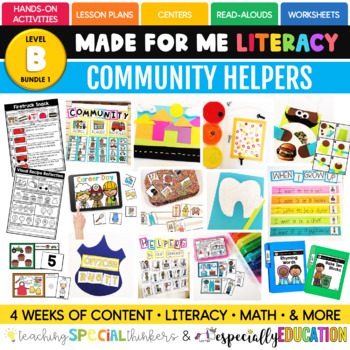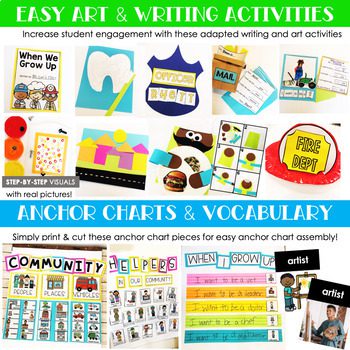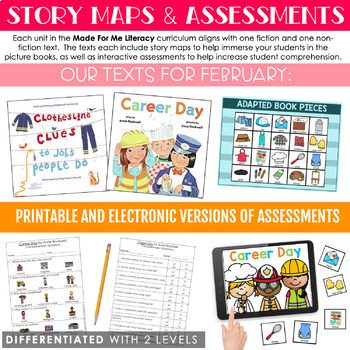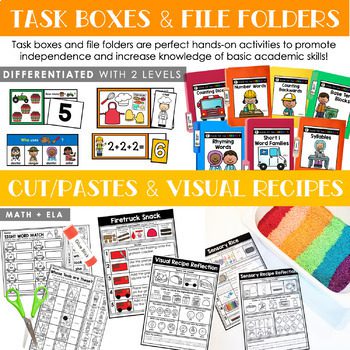Early elementary literacy is not just about reading and answering questions. Literacy encompasses exploring and generating written, spoken, and visual content. This broadens and enriches our comprehension of tangible and imaginary realms, granting us profound insights into our sense of self, the experiences of others, and the broader world we inhabit.
Made for Me Literacy units are designed to help all students achieve their potential, especially special education students who need extra help with reading comprehension across curricular areas. Each month focuses on monthly literacy activities your learners will love.
In February, the Made for Me Literacy bundle is all about community helpers! The month’s theme focuses on careers and how others are involved in the community.
Focus on Fiction

Community helpers are everywhere! First, story time starts with Career Day by Ann Rockwell. In this fiction piece, your students will learn vocabulary words, assemble a story map, complete comprehension questions, and take an assessment.
Review story elements with the youngest learners in this fiction connection to careers in the community.
Nonfiction Connection
Nonfiction texts are also included in the community helpers unit.
After introducing the fiction piece, use the text Clothesline Clues to help your students explore community careers. Students will engage in matching vocabulary through a picture walk, answer comprehension questions, and take an assessment. Encourage your learners to make connections between fiction and nonfiction texts.
Anchor Charts to Make Connections

Your students can see themselves as community helpers, and you can help them make those connections with anchor charts.
First, “I can” statements focus on future careers with the community helper pocket chart.
Next, “I want” statements are part of the “When I Grow Up Predictable Chart.” In this chart, students will discover and predict their future career and community roles. “Helpers in Our Community” and “Our Community People and Places” anchor charts focus on the roles of community helpers and places in the neighborhood.
Finally, the Community Helpers Tools Interactive Bulletin Board centers around what each community member needs to do their job right.
Hang these anchor charts to provide deeper context and connection within this February Made for Me Literacy unit.
Writing
Another focus of the community helpers unit is writing. Explore what your students want to be when they grow up. This is the first step in career exploration. It’s also a chance to write about their goals as a class community. Community building also happens through letter writing to classmates and friends in this writing portion of the community helpers unit.

Art
Projects like community collages, officer badges, and hats help integrate art into literacy activities. Your students will enjoy creating the community helpers’ art projects in this fun, engaging unit.
Math
Counting, other essential skills, and math vocabulary are also part of the Made for Me Literacy monthly activities. The community helpers lead students through skills like dice counting, ten frames, and base ten counting. Simple task cards and file folders will help bring math skills to your young learners.
More ELA
From sight words to vocabulary and rhyming, there are many English Language Arts skills to practice in the community helpers unit using visual and non-visual cues. Practice ELA skills with task cards and ready-to-go file folders.
Visual Recipes

Finally, the Made for Me Literacy bundle uses literacy and math skills to create edible and sensory recipes. Your students can make a fire truck snack or sensory rice with the community helpers unit! Visual recipes really bring literacy skills to life for young students. Let them create and learn!
These monthly literacy activities your learners will love help students improve their literacy and math skills! They also keep them engaged throughout the school year. February is all about community helpers and making your students feel like a part of the community and their future. Try this engaging unit in your primary classroom.
Leave a Reply